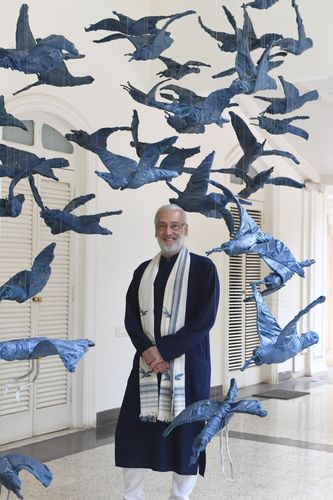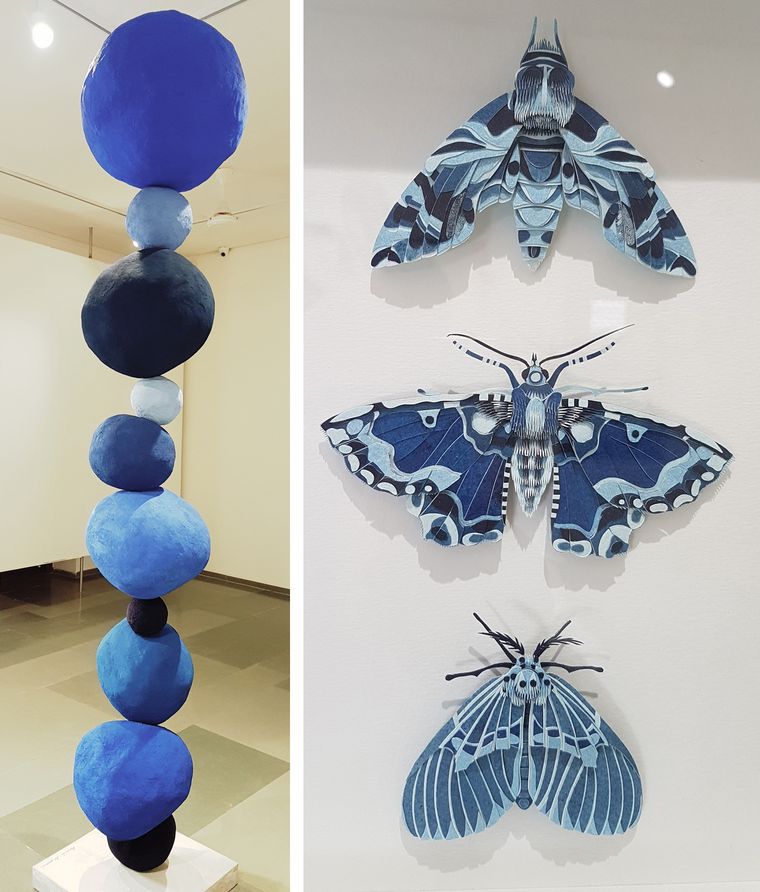As a child in West Africa, Malian artist Aboubakar Fofana learnt how some green leaves bleed blue. Much later, after a fulfilling career as a calligrapher and graphic designer in France, Fofana remembered this story, and thus began his journey to understand indigo and his African heritage. The 52-year-old artist has mastered the complicated technique of fermented indigo dyeing using the leaves. At the Kasturbhai Lalbhai Museum in Ahmedabad, he has mounted a wall-to-wall 'jeans' installation, showcasing the bewildering range of shades one can achieve with indigo dye. Hung dry on lines with pegs, the exhibit is urban, up-to-date and instinctively suitable—almost a visceral piece in a museum housing Mughal, Pahari and Rajput miniatures, Tibetan thangkas and artefacts from the Bengal school movement.
The jeans revolution is India may not have burst forth had the 88-year-old textile company Arvind Ltd in Ahmedabad not introduced denim in the domestic market in the 1980s. Today, it is one of the largest producers of denims globally. Its chairman and managing director Sanjay Lalbhai is the undisputed 'denim king' in India, with a net worth of $1.1 billion. He has repeatedly pointed out how launching denim, with its associated dye indigo, catapulted the company on the path of reinvention at a time when other mills were facing closure owing to power looms. “Of course, the best way to pay homage to this brilliant and magical dye would be to build a museum,” says Lalbhai, seated on a green leather Chesterfield-like sofa in an elegant study at his 114-year-old ancestral mansion that is now the Kasturbhai Lalbhai Museum. Named after his grandfather, the colonial-style museum is hosting Alchemy, a curtain-raiser exhibition on “indigo art objects” before the 2020 launch of the Arvind Indigo Museum, a 20,000sqft space dedicated to artistic manifestations of indigo in the company's Naroda facility (the first metre of denim in India was produced there).
“Indigo has always been used in fabrics. We want to try and see how we can extend the vocabulary,” says Lalbhai. From cement, brick, steel to wood, sandstone, black ash, VHS tapes, beetle wings, epoxy resin, much extension of the medium has been executed in the ongoing exhibition. “For example, indigo on aluminum has never been tried before. It is very difficult to get aluminum to absorb indigo,” says Lalbhai, pointing to Manish Nai's abstract creations with the metal in compressed layers.
Lithuanian-born Victoria Andrejeva's The Nest gathers rubbish from Arvind Mill’s backyard and composes a cocooned wooden cabin of sorts, which is eerily mysterious and meditative at the same time. Kirit Chitara's Mata Ni Pachedi cloth painting in a natural indigo background is a standout in the crafts section. Chitara's family is the only remaining practitioner of the traditional art form, also known as the 'Kalamkari of Gujarat'. In the run-up to the opening of Alchemy on January 25, a chef-restaurateur approached Lalbhai, offering to curate an entire menu culled out of indigo. “I got so excited.
But I also knew indigo might be FDA approved, but not approved in India for consumption. Seriously, though, it opened up my mind about future possibilities,” says Lalbhai, who has plans to incorporate video, AI and other futuristic ideas in his indigo idiom. One particular exhibit by Vipul Mahadevia, also the creative head of Arvind Indigo Museum, has a constellation of concentric circles on the wall. They are enlarged depictions of indigo reacting with sulphuric acid, salt, vinegar, sugar, fructose and turmeric under a microscope. The whole exhibition has used around 150kg of natural indigo.
For the Arvind Indigo Museum, which will be a public institution, Lalbhai says that his tastes would not have a bearing on the choice of artists. “All great institutions have become great because no one person's voice has an overriding power; it is a collective wisdom of many diverse minds,” he says. “Your passion is your private matter. Museums are always managed.”
His grandfather Kasturbhai was closely associated with Mahatma Gandhi and the Swadeshi movement. “To keep Indian heritage intact, my grandfather bought the entire Tagore collection of art to prevent it from going abroad, even though he never bought a single painting in his life,” he says. Considering how indigo is native to India, Lalbhai, too, is keeping our heritage alive.



